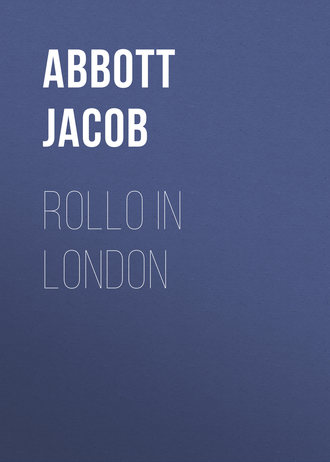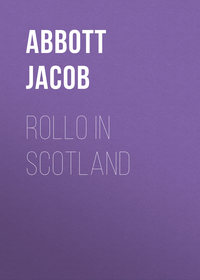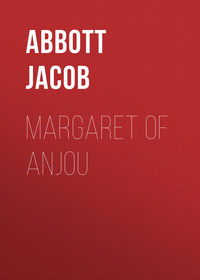 полная версия
полная версияRollo in London
After this the yeoman of the guard led his party to a great many other curious places. He showed them the room where the crowns and sceptres of the English kings and queens, and all the great diamonds and jewels of state, were kept. These treasures were placed on a stand in an immense iron cage, so that people assembled in the room around the cage could look in and see the things, but they could not reach them to touch them.
They were also taken to see various prison rooms and dungeons where state prisoners were kept; and also blocks and axes, the implements by which several great prisoners celebrated in history had been beheaded. They saw in particular the block and the axe which were used at the execution of Anne Boleyn and of Lady Jane Grey; and all the party looked very earnestly at the marks which the edge of the axe had made in the wood when the blows were given.
The party walked about in the various buildings, and courts, and streets of the Tower for nearly two hours; and then, bidding the yeoman good by, they all went away.
"Now," said Rollo, as soon as they had got out of the gate, "which is the way to the Tunnel?"
The Tunnel is a subterranean passage under the Thames, made at a place where it was impossible to have a bridge, on account of the shipping. They expected, when they made the Tunnel, that it would be used a great deal by persons wishing to cross the river. But it is found, on trial, that almost every body who wishes to go across the river at that place prefers to go in a boat rather than go down into the Tunnel. The reason is, that the Tunnel is so far below the bed of the river that you have to go down a long series of flights of stairs before you get to the entrance to it; and then, after going across, you have to come up just as many stairs before you get into the street again. This is found to be so troublesome and fatiguing that almost every one who has occasion to go across the river prefers to cross it by a ferry boat on the surface of the water; and scarcely any one goes into the Tunnel except those who wish to visit it out of curiosity.
The stairs that lead down to the passage under the river wind around the sides of an immense well, or shaft, made at the entrance of it. When Mr. George and Rollo reached the bottom of these stairs they heard loud sounds of music, and saw a brilliant light at the entrance to the Tunnel. On going in, they saw that the Tunnel itself was double, as it consisted of two vaulted passage ways, with a row of piers and arches between them. One of these passage ways was closed up; the other was open, and was lighted brilliantly with gas all the way through. But what most attracted Rollo's attention was, that the spaces between the piers all along the Tunnel were occupied with little shops, each one having a man, a woman, or a child to attend it. As Mr. George and Rollo walked along, those people all asked them to stop and buy something at their shops. There were pictures of all kinds, and little boxes, and views of the Tunnel, with magnifying glasses to make them look real, and needle cases, and work boxes, and knickknacks of all kinds for people to buy and carry home as souvenirs, or to show to their friends and say that they bought them in the Tunnel.

SHOPPING IN THE TUNNEL.
Besides these things that were for sale, there were various objects of interest and curiosity, such as electric machines where people might take shocks, and scales where they might be weighed, and refreshment rooms that were formed in the passage way that was not used for travel; and in one place there was a little ball room arranged there, where a party might, if they chose, stop and have a dance.
Rollo and Mr. George walked through the Tunnel, and then came back again. As they came back, Rollo stopped at one of the shops and bought a pretty little round box, which he said would do for a wafer box, and would also serve as a souvenir of his visit to the place.
Mr. George and Rollo concluded, after ascending again to the light of day, that they would go home by water; so they went out to the end of a long floating pier, which was built, as it happened, exactly opposite the entrance to the Tunnel. They sat down on a bench by a little toll house there, to wait for a steamer going up the river.
"It must have been just about under here," said Rollo, "that I bought my little wafer box in the Tunnel."
"Yes," said Mr. George; "just about."
In a few minutes a steamer came along and took them in. She immediately set off again; and, after passing under all the London bridges and stopping on the way at various landings, she set them down at Hungerford stairs, and they went to their lodgings.
Mr. George and Rollo had various other adventures in London which there is not space to describe in this volume. Rollo did not, however, have time to visit all the places that he wished to see; for, before he had executed half the plans which he and his uncle George had projected, he received a sudden summons to set out, with his father, and mother, and Jennie, for Edinburgh.
1
Whenever shillings or sixpences are mentioned in this book, English coin is meant. As a general rule, each English denomination is of double the value of the corresponding American one. Thus the English penny is a coin as large as a silver dollar, and it is worth two of the American pennies. The shilling is of the value of a quarter of a dollar; and a sixpence is equal to a New York shilling.
2
See frontispiece.
3
Such a body of ecclesiastics is called a chapter.
4
The reader will recollect, from the description of Westminster Abbey, that the central part of the body of the church is called the nave, and that the parts of each side of the nave, beyond the ranges of columns that border it on the north and on the south, are called the aisles, and that the aisles are not so high usually as the nave. The long, vacant space which our party was now traversing was directly over the south aisle. They were coming towards the spectator, in the view of the church represented in the engraving. You see two towers in the front of the building shown in the engraving. The one on the right hand is on the south, and is called the clock tower. The other tower, which is on the north, is called the belfry. The party were coming along over the south aisle and south transept towards this south tower. If you read this explanation attentively, comparing it with the engraving, and compare the rest of the description with the engraving, you will be able to follow the party exactly through the whole of their ascent.
5
The works of this clock are on such a scale that the pendulum is fourteen feet long, and the weight at the end weighs more than one hundred pounds. The minute hand is eight feet long, and weighs seventy-five pounds.
6
These club houses are very large and splendid mansions belonging to associations of gentlemen called clubs. Some of the clubs contain more than a thousand members. The houses are fitted up in the most luxurious manner, with reading rooms, libraries, dining rooms, apartments for conversation, and for all sorts of games, and every thing else requisite to make them agreeable places of resort for the members. The annual expenditure in many of them is from thirty to fifty thousand dollars.
7
It was while these workmen were going out in this way from the yard that the incident of the little girl falling into the dock occurred, as has been already related.




![Rollo's Philosophy. [Air]](/covers_200/36364270.jpg)






